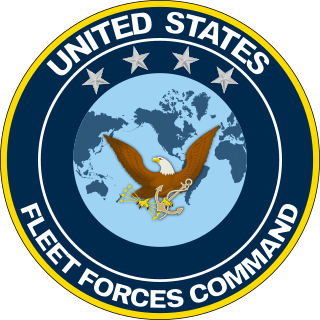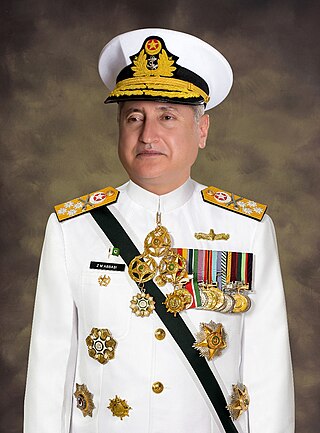Commodore is a senior naval rank used in many navies which is equivalent to brigadier or brigadier general and air commodore. It is superior to a navy captain, but below a rear admiral. It is either regarded as the most junior of the flag officers rank or may not hold the jurisdiction of a flag officer at all depending on the officer's appointment. Non-English-speaking nations commonly use the rank of flotilla admiral, counter admiral, or senior captain as an equivalent, although counter admiral may also correspond to rear admiral lower half abbreviated as RDML.

The United States Fleet Forces Command (USFF) is a service component command of the United States Navy that provides naval forces to a wide variety of U.S. forces. The naval resources may be allocated to Combatant Commanders such as United States Northern Command (USNORTHCOM) under the authority of the Secretary of Defense. Originally formed as United States Atlantic Fleet (USLANTFLT) in 1906, it has been an integral part of the defense of the United States of America since the early 20th century. In 2002, the Fleet comprised over 118,000 Navy and Marine Corps personnel serving on 186 ships and in 1,300 aircraft, with an area of responsibility ranging over most of the Atlantic Ocean from the North Pole to the South Pole, the Caribbean Sea, Gulf of Mexico, and the waters of the Pacific Ocean along the coasts of Central and South America.

The North America and West Indies Station was a formation or command of the United Kingdom's Royal Navy stationed in North American waters from 1745 to 1956, with main bases at the Imperial fortresses of Bermuda and Halifax, Nova Scotia. The North American Station was separate from the Jamaica Station until 1830 when the two combined to form the North America and West Indies Station. It was briefly abolished in 1907 before being restored in 1915. It was renamed the America and West Indies Station in 1926. It was commanded by Commanders-in-Chief whose titles changed with the changing of the formation's name, eventually by the Commander-in-Chief, America and West Indies Station.

The Commander United Kingdom Strike Force is a senior post in the Royal Navy.

The Supreme Allied Commander Atlantic (SACLANT) was one of two supreme commanders of the North Atlantic Treaty Organisation (NATO), the other being the Supreme Allied Commander Europe (SACEUR). The SACLANT led Allied Command Atlantic was based at Norfolk, Virginia. The entire command was routinely referred to as 'SACLANT'.

United States Naval Forces Central Command (NAVCENT) is the United States Navy element of United States Central Command (USCENTCOM). Its area of responsibility includes the Red Sea, Gulf of Oman, Persian Gulf, and Arabian Sea. It consists of the United States Fifth Fleet and several other subordinate task forces, including Combined Task Force 150, Combined Task Force 158 and others.

U.S. Naval Forces Southern Command is the naval element of United States Southern Command (USSOUTHCOM). Its areas of operation include South America, Central America, the Caribbean and surrounding waters. Its headquarters are located at Naval Station Mayport, Florida. USNAVSO is currently under the command of General Laura J. Richardson.

Rear Admiral Nigel Stephen Coates, was a senior officer in the Royal Australian Navy.

Vice-Admiral Philip Dean McFadden, CMM, CD is a retired officer of the Canadian Forces. He was chief of the Maritime Staff from 2009 to 2011 and last to hold the post before it was renamed to commander of the Royal Canadian Navy.
Rear-Admiral William Moss Landymore, OBE, CD was a Canadian naval officer. Born in Brantford, Ontario, Landymore joined the Royal Canadian Navy in 1936, but spent much of early career training with the Royal Navy. During World War II, Landymore returned to the Royal Canadian Navy and served aboard destroyers in the Battle of the Atlantic, surviving two sinkings. By the end of the war Landymore had taken a series of positions in Ottawa before returning to destroyer command during the Korean War. He was promoted through the ranks eventually becoming the first Commander of Maritime Command. Landymore became embroiled in a public feud with the Minister of National Defence following the Unification of the Canadian Armed Forces and resigned as a result. He died at Halifax, Nova Scotia.
Fleet Command is responsible for the command, operations, readiness, training and force generation of all ships, submarines, aircraft squadrons, diving teams, and shore establishments of the Royal Australian Navy. Fleet Command is headquartered at HMAS Kuttabul in Sydney, and is led by the Commander Australian Fleet (COMAUSFLT), also referred to as Fleet Commander Australia (FCAUST), which is a rear admiral (two-star) appointment.

The Commander of the Royal Canadian Navy is the institutional head of the Royal Canadian Navy. This appointment also includes the title Chief of the Naval Staff and is based at National Defence Headquarters in Ottawa, Ontario. This individual reports to the Chief of the Defence Staff, who then responds to the Commander-in-Chief of the Canadian Armed Forces.

Admiral Zafar Mahmood AbbasiNI(M) HI(M) SI(M) BJSN is a retired four-star admiral of the Pakistan Navy who served as the 16th Chief of the Naval Staff (CNS) of Pakistan Navy from 7 October 2017 until 7 October 2020.

Admiral Sir Philip Andrew Jones, is a retired senior Royal Navy officer. After service in the South Atlantic in 1982 during the Falklands War, he commanded the frigates HMS Beaver and HMS Coventry. He went on to be Flag Officer, Scotland, Northern England and Northern Ireland, Commander United Kingdom Maritime Forces and Assistant Chief of the Naval Staff before being appointed Fleet Commander and Deputy Chief of the Naval Staff. Jones served as First Sea Lord from April 2016 to June 2019.

Vice-Admiral Maurice Frank Ronald "Ron" Lloyd is a retired Royal Canadian Navy officer who became the 35th Commander of the Royal Canadian Navy on 23 June 2016.

Rear-Admiral William Shaun Truelove is a Royal Canadian Navy officer.

Rear-Admiral John F. Newton is a retired Royal Canadian Navy officer and now liaison officer with Veterans Affairs Canada.

Admiral Arthur Gerard McDonald, is a Royal Canadian Navy admiral who served as Chief of the Defence Staff of the Canadian Forces from January 14, 2021, until February 24, 2021, when he voluntarily stepped aside due to an investigation by the Canadian Forces National Investigation Service. On November 25, 2021, McDonald was formally relieved of his command, and replaced permanently by General Wayne Eyre who had held the post during the interim.

Scott Edward George Bishop is a Canadian naval flag officer serving as a Vice Admiral in the Royal Canadian Navy. He presently serves as Canada's Military Representative to the NATO Military Committee, and was commander of the Canadian Forces Intelligence Command from 2016 to 2021.
The Commander-in-Chief, Leith formally known as the Commander-in-Chief at Leith and on the Coast of Scotland was a military commander and formation of the Royal Navy from 1745 to 1825.















